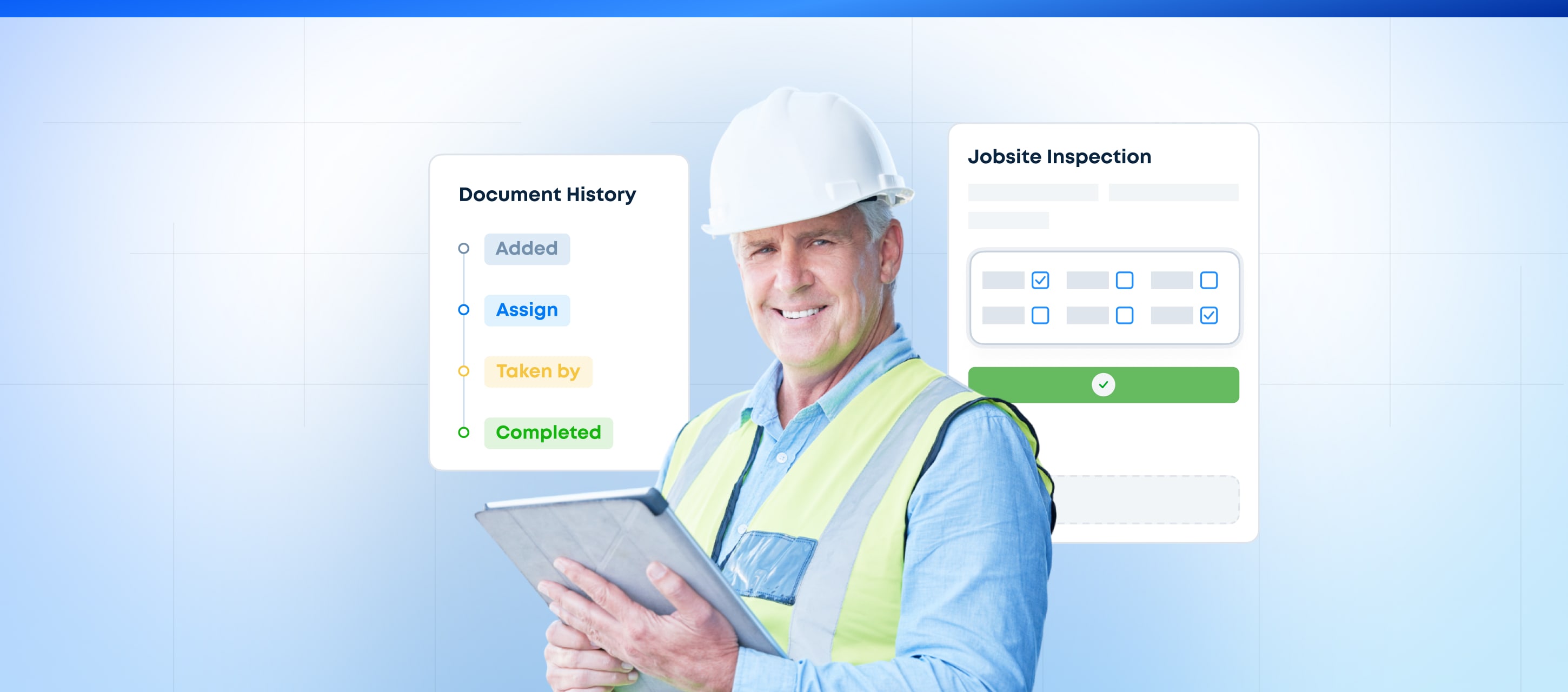Whether you’re building a skyscraper or a small office, understanding the ins and outs of project management can make all the difference in helping you stay on time, on budget, and on track.
Here, we’ll dive into what construction project management really involves and who’s responsible for making it all happen.
Contents:
What Is Construction Project Management?
Construction project management is the process of bringing a project to life by planning, coordinating, and managing all its moving parts.
This includes balancing costs, timelines, resources, and teams to keep the project moving smoothly. A big part of this process is keeping construction productivity high. The end goal is to finish on time, within budget, and up to quality standards.
Since each project has a clear endpoint, building project management is temporary. The process begins with the project and wraps up once the work is done.
Roles and Responsibilities in Construction Project Management
Project management in construction is all about teamwork. Let’s take a look at who’s who and how they each play a part in making their project a success.
Project Owner
The project owner is the one who gets the ball rolling. They’re the visionary behind the project, the one who funds it and makes key decisions to see it through.
What They Do:
- Set the vision: Decide what the project will achieve.
- Fund the project: Provide the necessary money and resources.
- Pick the team: Hire the general contractor and project manager.
- Make big decisions: Approve budgets, delivery methods, timelines, and major changes.
- Keep things on track: Review progress and sign off on key milestones.
Skills They Need:
- Strong decision-making and strategic planning.
- Financial management and budgeting.
- A good grasp of construction processes and delivery methods.
Who They Report To:
If self-funded, the project owner doesn’t report to anyone. But if there are other backers, like a board or investors, they’ll need to report to them.
Try the Fluix ROI Calculator to see if automation can boost your project
Project Manager
The construction project manager ensures everything runs smoothly from start to finish. They plan, solve problems, and keep their teams in the loop.
What They Do:
- Craft the plan: Build the project timeline and outline tasks so everyone knows what to do and when.
- Manage the budget: Track costs, make adjustments, and keep the project within budget.
- Assess and prepare for risks: Identify risks and have a plan ready to handle them.
- Tackle challenges: Spot issues early and find quick fixes to keep things moving.
- Track progress: Regularly check in and make adjustments to stay on track.
- Ensure quality: Make sure everything meets the required standards and regulations.
- Build relationships: Communicate with the project owner, management team, and on-site crew.
Skills They Need:
- Strong leadership and planning.
- Project and budget management.
- Problem-solving, risk management, and relationship-building.
Who They Report To:
The project manager usually reports to the project owner,
General Contractor
The general contractor (GC) is the on-the-ground leader, managing a construction project’s day-to-day operations. They make sure everything is in place to keep the project moving forward.
What They Do:
- Oversee construction: Manage the entire construction process on-site.
- Assemble the on-site team: Hire and coordinate construction professionals, including subcontractors.
- Enforce safety: Ensure every person on-site follows safety protocols.
- Handle logistics: Get permits, licenses, and schedule inspections.
- Manage resources: Ensure materials, labor, and equipment are where they need to be.
- Keep everyone informed: Report daily progress and keep the project manager in the loop.
Skills They Need:
- Strong organizational and strategic thinking.
- Deep knowledge of construction and project management.
- Ability to juggle multiple tasks and maintain clear communication.
Who They Report To:
The GC reports to the project owner. In some cases, they may report to the construction project manager.
Subcontractors
Subcontractors are the specialists. They’re hired to handle specific parts of the job, like plumbing or electrical work, that need expert hands.
What They Do:
- Specialize in trades: Focus on specific areas like electrical, plumbing, or carpentry.
- Keep quality high: Follow industry standards and safety rules.
- Work with the GC: Complete tasks as directed by the general contractor.
- Collaborate on-site: Work closely with other trades and on-site crew.
- Offer expertise: Provide practical advice and solutions from their field.
Skills They Need:
- Technical expertise in their trade.
- Strong attention to detail and quality.
- Ability to work well with others on a busy site.
Who They Report To:
Subcontractors report to the GC.
Certifications They Need:
- Relevant trade certifications, like being a licensed electrician or certified plumber.
Everyone on the job site needs the right Occupational Safety and Health Administration (OSHA) training to stay safe. This might mean taking a 10-hour or 30-hour OSHA course for general safety, plus any extra training for their specific tasks or trades.
Having a clear chain of command is crucial, but what really drives success is the communication that flows through it. When everyone’s clear on what needs to happen and when, it’s easier to avoid mistakes and keep your project moving forward. That’s why communicating on the construction site is so crucial.
Digital solutions for construction management, for example the ones provided by Fluix, is a great way to make sure everyone’s on the same page. With real-time updates, instant notifications, and a central spot for all the details, it helps you catch and fix issues before they slow you down.
Construction Project Management Methodologies
When it comes to project management for construction projects, there’s no one-size-fits-all approach. Different projects call for different strategies, and that’s where methodologies come in.
We’ll explore the main approaches that can guide your project and help you reach your goals..
For Precision and Focus: Critical Path Method (CPM)
The Critical Path Method (CPM) zeroes in on what matters most. It highlights the tasks that are connected and need to stay on schedule to keep the project moving forward. These are the tasks that, if delayed, would cause the entire project to fall behind.
CPM is like your project’s GPS, plotting the best route through your tasks to help you reach your goals without any unexpected detours.
This methodology is excellent for spotting potential roadblocks early. This allows you to plan, manage risks, and have backup options ready. Plus, it ensures you’re using resources wisely by concentrating on the most crucial tasks without spreading your team too thin.
How it works: First, list out all the tasks in your construction project. Then, determine which tasks depend on others and map out the order they need to be done in. Those that can’t be delayed make up your “critical path.” By focusing on these, you’ll keep everything on schedule.
Paper lists slowing you down? Organize tasks, track progress, and send approvals digitally
For Structure: Waterfall Project Management
The waterfall method is a straightforward way to manage projects, prompting you to tackle construction stages in a specific order. It’s like climbing a staircase, you take one step at a time.
It’s the oldest method in the field and remains the go-to approach. Construction professionals love it because it’s so organized. You always know what’s next, making it simple to plan and manage projects.
Waterfall management works especially well when the project owner’s expectations are clear and unlikely to change, helping you stay on track and deliver as planned.
How it works: You break down the construction process into stages, like initiation, planning, procurement, construction, and closeout. You complete one stage before moving on to the next—start with initiation, then move to planning, and so on. Each stage flows naturally into the next, just like water running down a waterfall.
For Maximum Efficiency: Lean Project Management
Lean project management is about getting the most value with the least waste. It focuses on continuous improvement, always finding better and more efficient ways to get things done throughout the construction project lifecycle.
Lean management is popular because it saves time and money by cutting unnecessary steps and using resources wisely. But collaboration is key here. The whole construction team must work together to maximize efficiency and keep the project on track.
Digital transformation in construction can play a big role here by providing the tools needed to support lean principles.
How it works: You plan the project from the top down, making sure time and materials are used as efficiently as possible along the way.
For Flexibility: Agile Project Management
Agile project management breaks your project into smaller, manageable steps. But unlike traditional construction methods, it doesn’t focus on doing a lot of planning before the work begins. Instead, it relies on adapting as the project unfolds.
Without planning, construction projects can hit snags since each phase builds on the one before it. That’s why agile project management isn’t usually the go-to method in construction. But it’s great to apply in the early stages, like initiation, where flexibility really helps.
How it works: Agile management divides projects into short, focused work periods called “sprints.” In each sprint, you tackle specific tasks, gather feedback, and then tweak your next steps. This way, you can make changes without throwing the whole project off track.
Finding the Right Fit
Each method offers a different way to approach to manage construction projects. But you don’t have to stick with just one. You can mix and match elements from different methods to fit your project’s needs. Often, a hybrid approach works best.
The Five Phases of Construction Project Management
A building project can be broken down into any number of stages or phases, but there are five broad steps that it should follow. These steps keep your project moving forward smoothly, helping you avoid legal, financial, or safety setbacks. Here’s a breakdown of the five stages of a construction project:
1. Initiation
This is where it all starts. The initiation phase lays the groundwork for success. It typically involves at least four distinct components:
- Feasibility Study: This helps the project owner figure out if the project is doable. During the study, they look at things like land use and costs to decide if the project is ready to go, needs changes, or should be reconsidered. If everything looks good, the project moves forward.
- Contractual Agreements: Contracts are drawn up with key people such as the general contractor and project manager. It’s important to clearly outline their roles at this stage to prevent any confusion later.
- Schematic Design: The creative process begins here. Architects and designers collaborate with the project owner to develop design ideas. This could include sketches, floor plans, site layouts, and details on materials.
- Delivery Method: The project owner decides how the project will be carried out. Options include Design-Bid-Build, Design-Build, or Construction Management at Risk (CMAR). Each option has its benefits, so it’s important to choose the one that best fits your project.
2. Pre-Construction
Before breaking ground, the pre-construction phase gets everything ready to implement the project. It includes the following elements:
- Permits and Approvals: It’s time to get the green light from local authorities. Whether it’s zoning, building, or environmental permits, having these early on keeps the project on track.
- Health and Safety: A health and safety plan is needed to cover all the bases—from protocols to emergency procedures. Keeping everyone safe on-site should always be a top priority.
- Team Organization: Get the crew together and make sure everyone understands their role. The goal is to be ready to hit the ground running once construction begins.
- Risk Management: No project is without challenges. By spotting potential risks, like delays or budget issues, you can plan ahead to handle them before they become problems.
- Cost Estimation: Developing a budget that accounts for labor, materials, and potential surprises is essential. Careful planning at this stage will keep your project financially sound.
3. Procurement
The procurement phase is all about sourcing what you need to build. Here’s what to focus on:
- Materials and Equipment: Get everything needed for the project. Double-check that all materials and equipment meet safety standards and ensure everything arrives on time so construction stays on schedule.
- Hiring Subcontractors: Subcontractors handle the specialized tasks. Take a close look at their bids and make sure they have the right certifications and training to get the job done right.
- Cost Control: Keeping an eye on spending is important. Smart budgeting will help you stay on track and ensure the project won’t run out of money as it moves forward.
4. Construction
The fourth phase in a project life cycle is where the actual construction takes place. It’s dominated by contractors and subcontractors performing daily duties to get the project off the ground. Here’s what to keep in mind:
- Execution: Make sure all tasks are completed on time. Delays in one area can throw off the whole project, so it’s important to keep everything moving according to plan.
- Quality Control: Don’t take it for granted—regularly check the work to ensure it meets standards. This way, you can avoid rework or other complications later on.
- Team Communication: Keep in touch with the team to share progress and tackle any questions that pop up. You might want to use construction field management software to make it easier to provide updates, fix problems quickly, and avoid any mix-ups.
5. Post-Construction
Even after building is done, there’s still some important wrap-up work to do. The most common tasks to tackle in this phase include:
- Final Walk-Through: Take a walk through the finished project to ensure it meets all specs and expectations. Usually, the project owner, manager, and general contractor take care of this to confirm everything’s up to standard.
- Punch List: During the walk-through, make a note of any remaining tasks or fixes, like minor repairs or touch-ups. Being thorough with your punch list ensures there are no loose ends later. This list will be passed on for final improvements.
- Project Closure: Complete all paperwork, return any rented equipment, and close out contracts with subcontractors. If any payments are still due, now’s the time to settle them.
Challenges in Construction Project Management
In the construction project life cycle, challenges are part of the job, and how you handle them can affect the outcome. Let’s take a look at some common hurdles and how you can tackle them.
Safety
When safety issues pop up, they can quickly throw a project off track —think delays, accidents, and setbacks. That’s why safety has to be a top priority from day one. It’s the only way to keep your team safe and your project running smoothly.
To make this happen, your team must fully understand the safety risks and how to handle them. This starts with comprehensive training and continues with regular safety talks.
Regularly inspecting equipment to ensure it’s in good condition is also crucial. After all, even the best training can’t prevent accidents if the tools themselves aren’t safe.
But remember, safety in construction isn’t just about following rules and using the right gear—it’s also about creating a culture where everyone feels comfortable speaking up. Encourage your team to share safety concerns, and let them know their input matters.
Budget Management
The budget is one thing you really can’t afford to get wrong. If you do, you might end up with overruns or, even worse, a stalled project. To avoid that, use forecasting tools to account for things like material prices and labor availability. These tools help you predict costs more accurately and steer clear of mistakes.
Don’t forget to include a little extra room in your budget for surprises. And remember, budgeting isn’t a one-and-done deal. Keep updating it as the project moves forward to stay on track.
Risk Management
Construction comes with its fair share of risks. Whether it’s supply chain issues or a sudden change in weather, things can easily go wrong. The key to handling risk is to spot potential issues early. Before the project even kicks off, list all the potential risks. Involve your team in this discussion, as they’re often the first to spot problems.
Use this information to create a construction risk management plan that outlines clear steps for prevention and what to do if something goes wrong. Always have a backup plan because, let’s face it, things rarely go exactly as expected.
How to Improve Project Management with Construction Management Software
Managing a construction project is no small feat—there are so many moving parts you need to track. That’s where Fluix comes in to make your life easier.
Fluix is powerful construction management software that helps you effortlessly stay in control of your project and processes.
Reasons You’ll Love Fluix:
Dashboards to Track Progress: Get a clear overview of your project’s progress at any moment. Whether it’s deadlines, budgets, or team performance, you’ll have all the information you need at a glance.
Real-Time Updates: No more waiting for news. Instant notifications keep everyone informed, so your team stays connected and your project stays on track.
Document Control: Manage and share all your project documents from one central hub. Your team will always have access to the most up-to-date files.
Workflows Made Simple: Automation handles repetitive, time-consuming tasks that eat up your team’s day—like sending approval requests or collecting completed forms.
Offline Mode: Work doesn’t stop when the internet does. Offline mode lets you and your team keep working, even without a connection.
Fluix keeps the entire construction process organized and running smoothly, so you can focus on getting the project done right.





